#mitsu × rui
Text

About to finish Kicho's dramatic route and I must say...
⚠️⚠️⚠️spoilers and route screenshots ahead⚠️⚠️⚠️
My heart cried hard for Mitsuhide because he's the love rival in the route.😭😭😭
This right here confirmed my suspicions that he was the love rival and my heart both soared and sank (like, how is that even possible?!?) as I read this.

We all know he holds his principles above all else. But to put protecting me (us) in the same category as his principles?!? Boy, that said A LOT.😭

And then he went ahead and said this? I had to stop reading because I wanted to tell him it wasn't true. Every time he was in the scene, I had to pause and remind myself I was there for Kicho.😅
"So, I may have been pushed towards your cousin (it's his route, i had no choice!😮💨), but you have always been on my mind and in my heart.🥺"
And then THIS??! THIS!
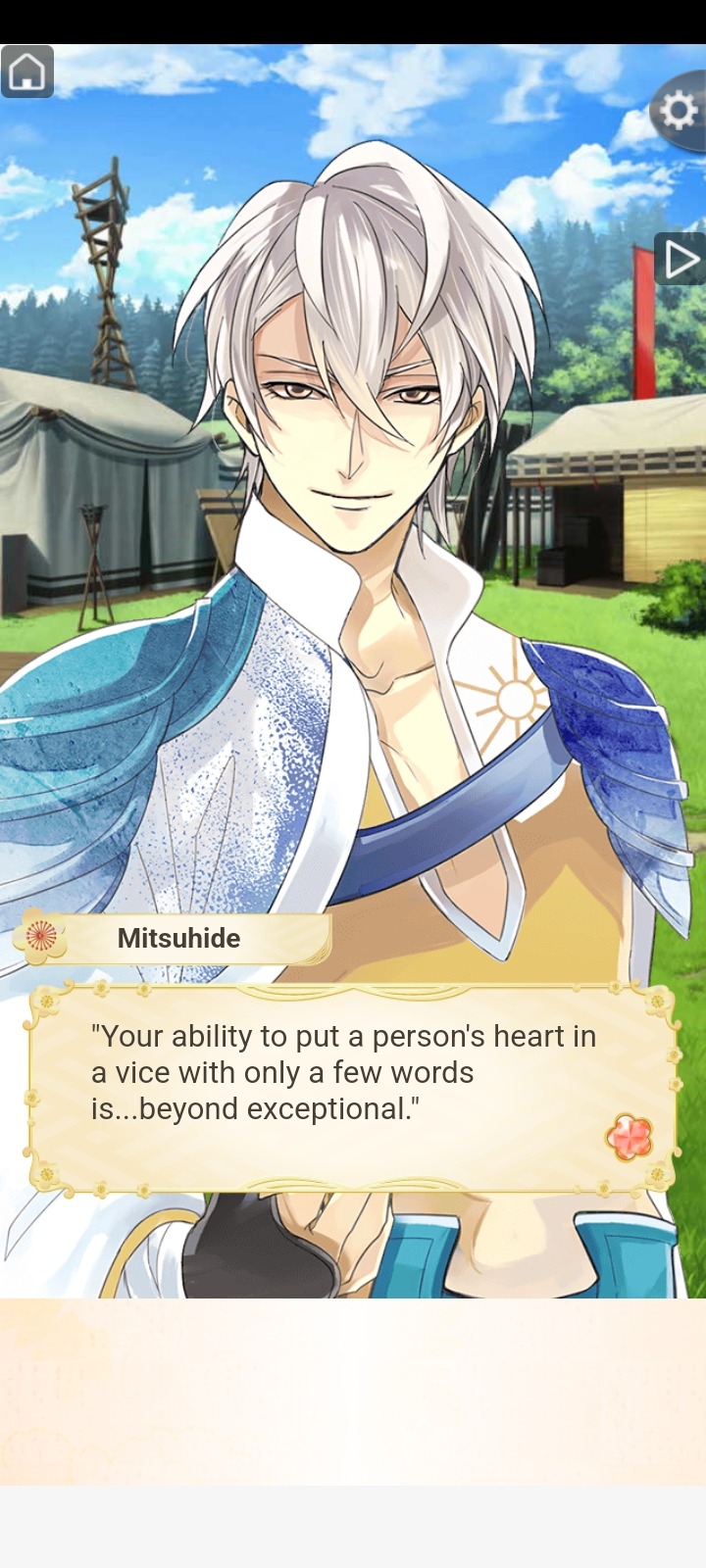
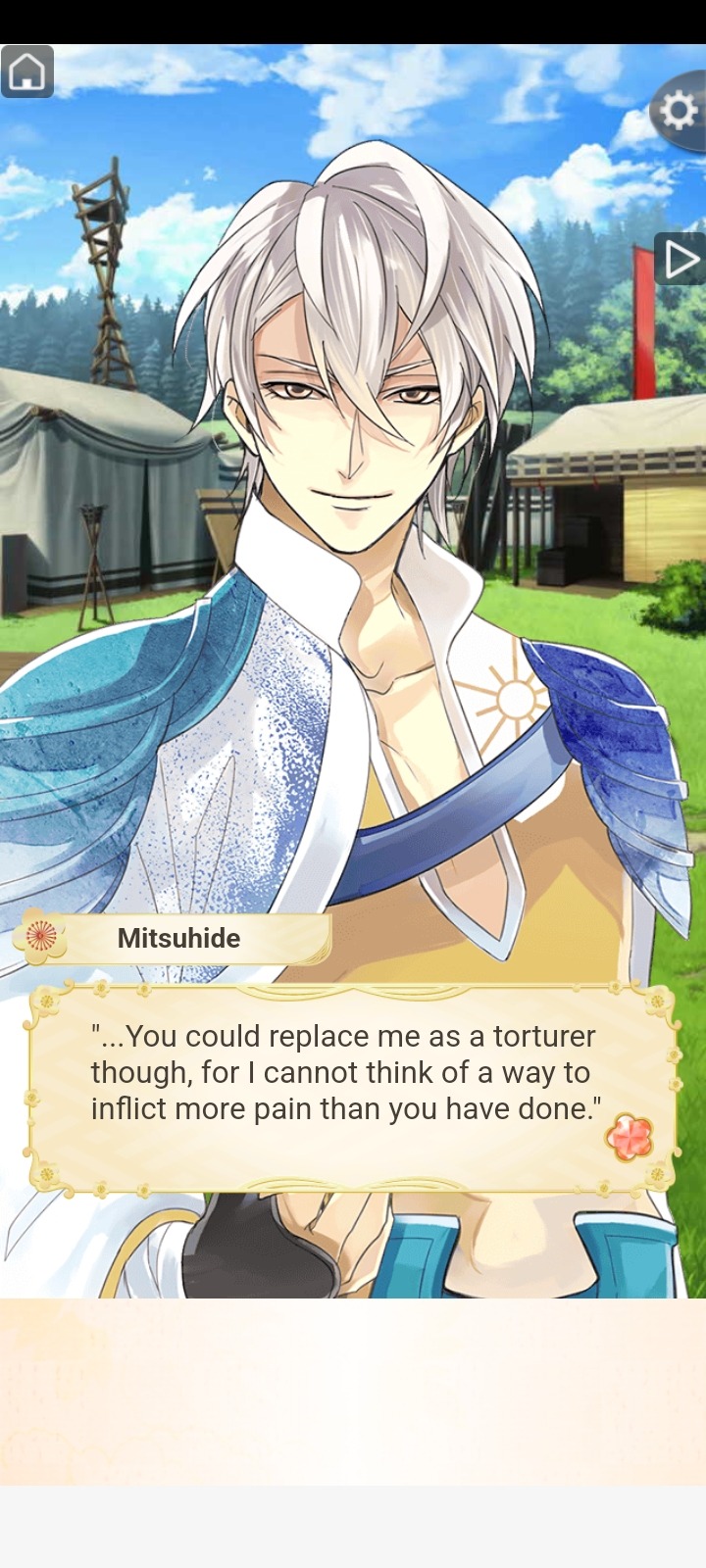
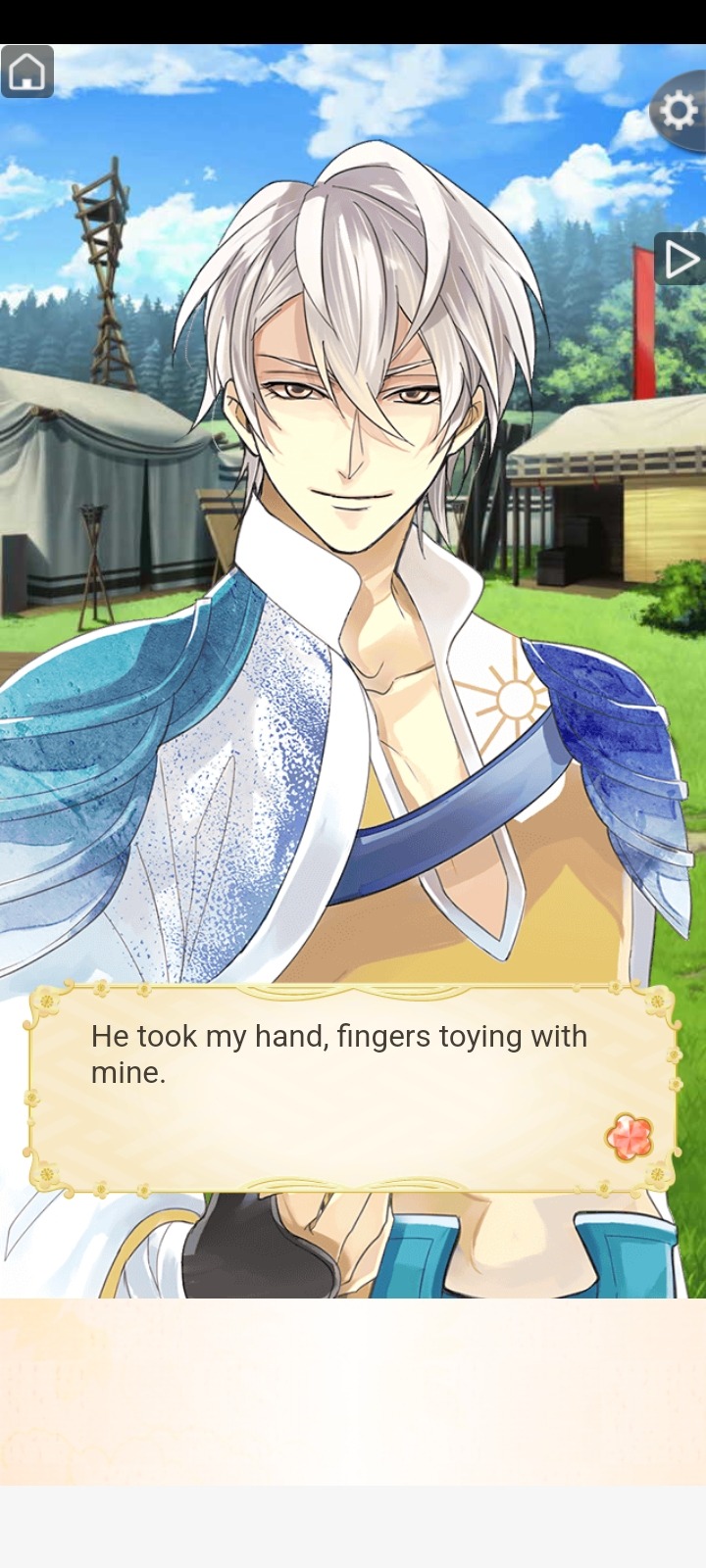



I don't even have enough words in me to describe everything I felt in this scene. He says all these... then in the same breath tells me to be happy with Kicho?? No. Just... no. I caaaaaaaaan't. I just caaaaaaan't.😭😭😭💔💔💔
So. Yeah. Art featuring Mitsu×Rui is the result of reading another man's route...😅
(this will be such an abrupt ending to my post coz I'm absolutely exhausted now since i woke up early and missed all my naps to work on this.😅)
#ikemen sengoku#ikesen#fan art#my art#ikemen#rui's art#ikesen mitsuhide#ikemen sausage#ikesen kichou#mitsu × rui#spoiler
153 notes
·
View notes
Text
Lylysha's Information Sheet
Name and Alter Number: Lylysha Gera Sheepie #1
Year Joined in the System: 2015
Birthday and Age: May 25th (18 Years)
Pronouns: She / Her
Left Eye Color: Light Blue
Right Eye Color: Red
Hair Colors: Black and Blue Fade
Headspace They Belong To: Every Headspace Area
Jobs: Princess, Maid, Pet Cat, Artist, Poet
Fronting Frequency: All the time
Best Friends in System: Night-Struck, Bri, Becca, Bactriss
Parents: Mitsu
Siblings: Tilnt, Carl
Relationships / Crushes: Len, KAITO, Akito, Toya, Tsukasa, Rui, Allen, Gallerian, Luka, Saki, Kohane, Emu, Nene, Ena, Riliane
Children: Starlight, Moonlight, Souta, Akira, Masumi, Kyou, Luna, Lavender, Mia, Erick, Eve, Ocean, Sapphire, Ellie.
Traits: Depressed, Shy, Friendly, Human, Half Animal
0 notes
Photo


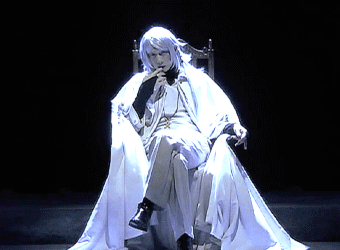
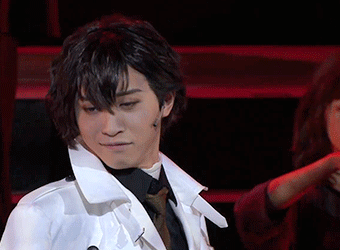
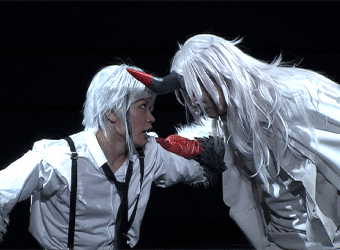
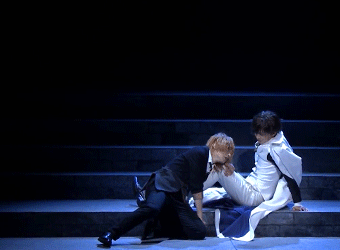
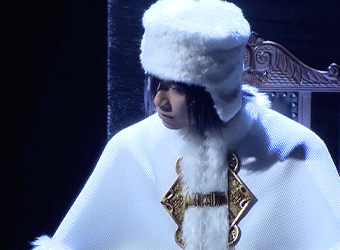


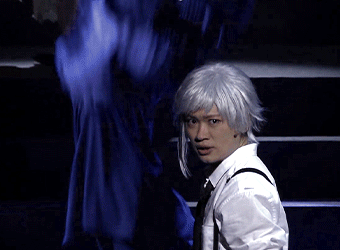
Bungo Stray Dogs on Stage
DEAD APPLE × デッドアップル
#bungou stray dogs on stage dead apple#bungou stray dogs on stage#dead apple#bungou stray dogs#bungo stray dogs#bsd stage#bsd#mine#ryunosuke akutagawa#atsushi nakajima#tatsuhiko shibusawa#osamu dazai#chuya nakahara#fyodor dostoevsky#kyoka izumi#shohei hashimoto#yuki torigoe#mitsu murata#rui tabuchi#keisuke ueda#yuta kishimoto#sakina kuwae#always living for shohei's acrobatics#also can we talk about keisuke throwing off his hat while suspended on a harness#king tingz#edit: for some reason the caption got removed skfjsfdsg
307 notes
·
View notes
Photo

[Announcement] 舞台「文豪ストレイドッグス DEAD APPLE」 (butai bungou stray dogs dead apple)
the show will be running from April 16th, 2021 to April 18th, 2021 (Osaka) @ COOL JAPAN PARK OSAKA WWホール (COOL JAPAN PARK OSAKA WW Hall) & April 23rd, 2021 to May 5th, 2021 (Tokyo) @ 日本青年館ホール (Nippon Seinenkan Hall)
Cast:

Torigoe Yuuki as Nakajima Atsushi (中島敦)

Kuwae Sakina as Izumi Kyouka (泉鏡花)

Hashimoto Shouhei as Akutagawa Ryuunosuke (芥川龍之介)

Ueda Keisuke as Nakahara Chuuya (中原中也)

Tabuchi Rui as Dazai Osamu (太宰治)

Kishimoto Yuuta as Fyodor D (フョードル・ D)

Murata Mitsu as Shibusawa Tatsuhiko (澁澤龍彦)
Ooishi Itsuki
Okamura Tatsuki
Yamanaka Keigo
Arimitsu Mao
Urashima Yuuna
Onotsuka Mao
Kobayashi Rara
Mimori Momo
homepage
twitter
natalie
#文豪ストレイドッグス#bungou stray dogs#bungo stray dogs#鳥越裕貴#torigoe yuuki#桑江咲菜#kuwae sakina#橋本祥平#hashimoto shouhei#植田圭輔#ueda keisuke#田淵累生#tabuchi rui#岸本勇太#kishimoto yuuta#村田充#murata mitsu#大石樹#ooishi itsuki#岡村樹#okamura tatsuki#山中啓伍#yamanaka keigo#有光麻緒#arimitsu mao#浦島優奈#urashima yuuna#小野塚茉央#onotsuka mao#小林らら
249 notes
·
View notes
Text

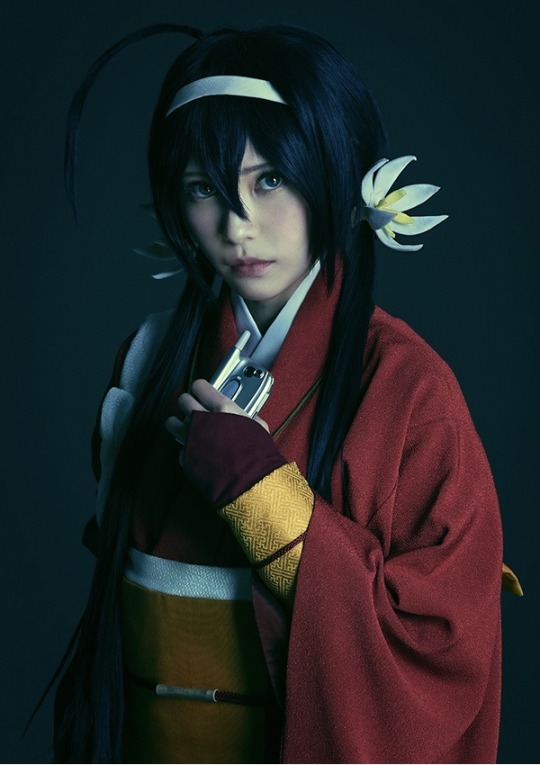

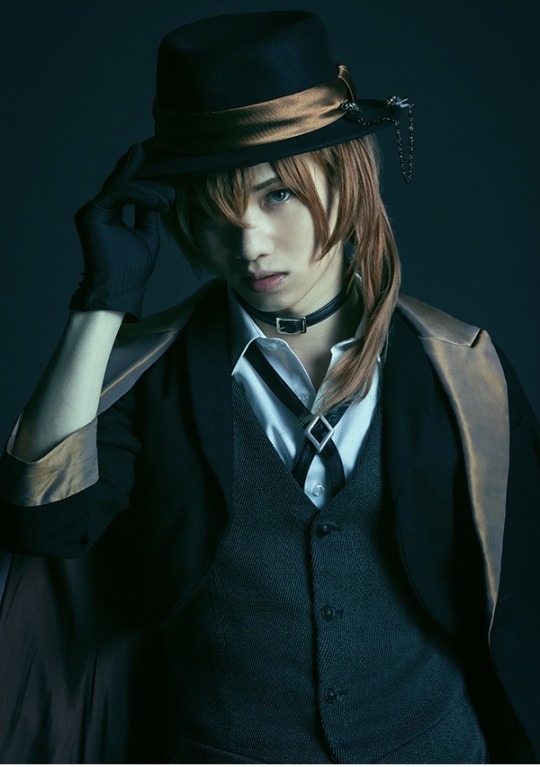


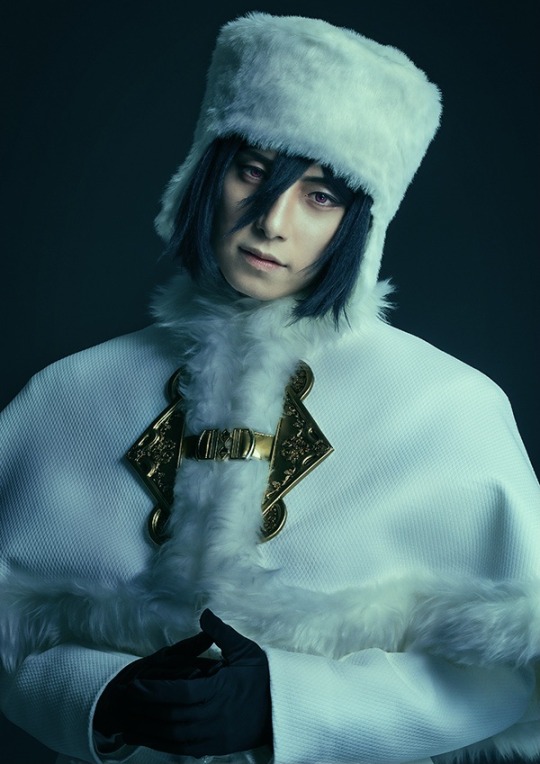
Cast photos from the official site for Dead Apple Stageplay - everyone be looking fine as hell tho ✨
http://bungo-stage.com/cast.html
#bsd#bsd stage#bungou stray dogs#atsushi nakajima#akutagawa ryuunosuke#kyouka izumi#chuuya nakahara#dazai osamu#fyodor dostoevsky#shibusawa tatsuhiko#yuki torigoe#sakina kuwae#shohei hashimoto#ueda keisuke#rui tabuchi#yuta kishimoto#mitsu murata#bsd stage play
198 notes
·
View notes
Photo

[Video] 舞台「文豪ストレイドッグス DEAD APPLE」 (butai bungou stray dogs dead apple)
the DVD/Blu-ray will be released on September 29th, 2021☆ ☆ ☆
☆ DVD ☆ Blu-ray ♪ Amazon
☆ DVD ☆ Blu-ray ♪ CD Japan
#dvd#blu-ray#文豪ストレイドッグス#bungou stray dogs#bungo stray dogs#鳥越裕貴#torigoe yuuki#桑江咲菜#kuwae sakina#橋本祥平#hashimoto shouhei#植田圭輔#ueda keisuke#田淵累生#tabuchi rui#岸本勇太#kishimoto yuuta#村田充#murata mitsu#大石樹#ooishi itsuki#岡村樹#okamura tatsuki#山中啓伍#yamanaka keigo#有光麻緒#arimitsu mao#浦島優奈#urashima yuuna#小野塚茉央
20 notes
·
View notes
Text
Bungo Stray Dogs the Movie: BEAST 2nd PV & Visual
BSD Beast Official revealed the second trailer & visual of Bungo Stray Dogs the Movie: BEAST. GRANRODEO as a theme song performer.
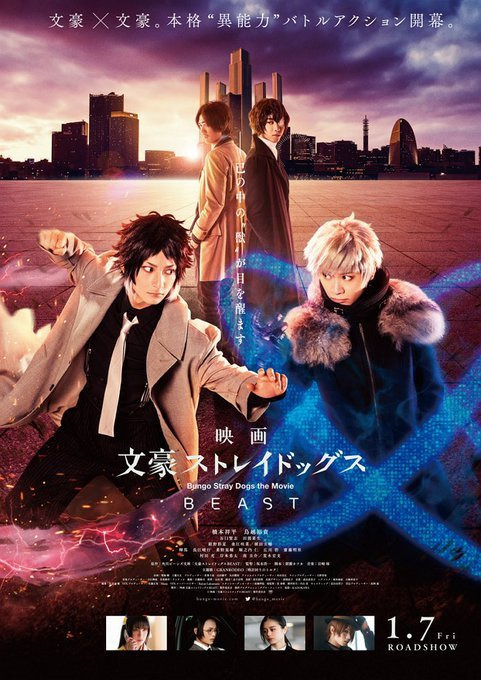
youtube
Cast members:
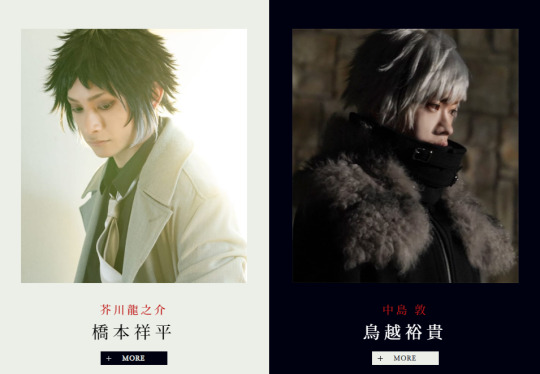
Akutagawa Ryunosuke - Hashimoto Shohei
Nakajima Atsushi - Torigoe Yuki
Armed Detective Agency
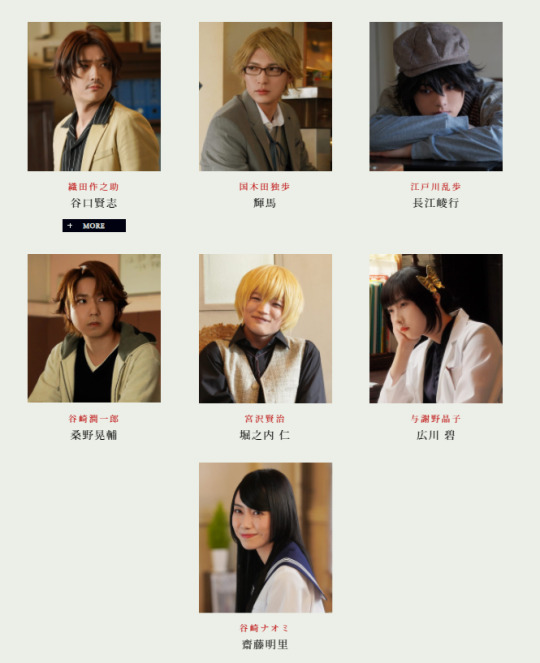
Oda Sakunosuke - Masashi Taniguchi
Kunikida Doppo - Teruma
Edogawa Ranpo - Nagae Ryoki
Tanizaki Junichiro - Kuwano Kosuke
Miyazawa Kenji - Horinochi Hitoshi
Yosano Akiko - Imamura Miho
Tanizaki Naomi - Saito Akari
Port Mafia
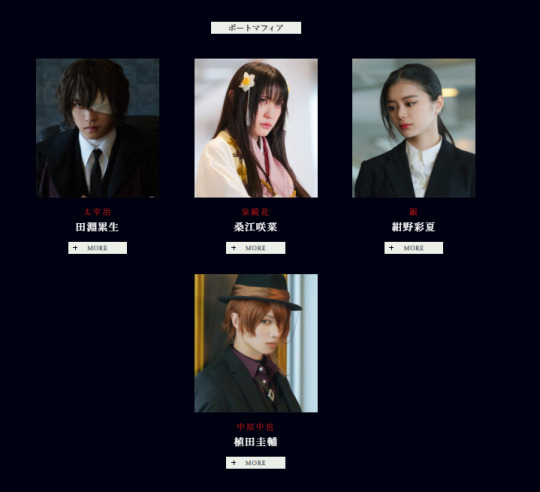
Dazai Osamu - Tabuchi Rui
Izumi Kyoka - Kuwae Sakina
Gin - Ayaka Konno
Nakahara Chuya - Ueda Keisuke
Others

Shibusawa Tatsuhiko - Murata Mitsu
Fyodor Dostoevsky - Kishimoto Yuta
Sakaguchi Ango - Araki Hirofumi
Director - Minami Keisuke
386 notes
·
View notes
Text
god..
Kishimoto yuta(Fyodor Dostoyevsky)
Murata Mitsu (Shibusawa Tatsushiko)
Tabuchi Rui(Dazai Osamu)



79 notes
·
View notes
Text
BUNGO STRAY DOGS DEAD APPLE STAGE PLAY
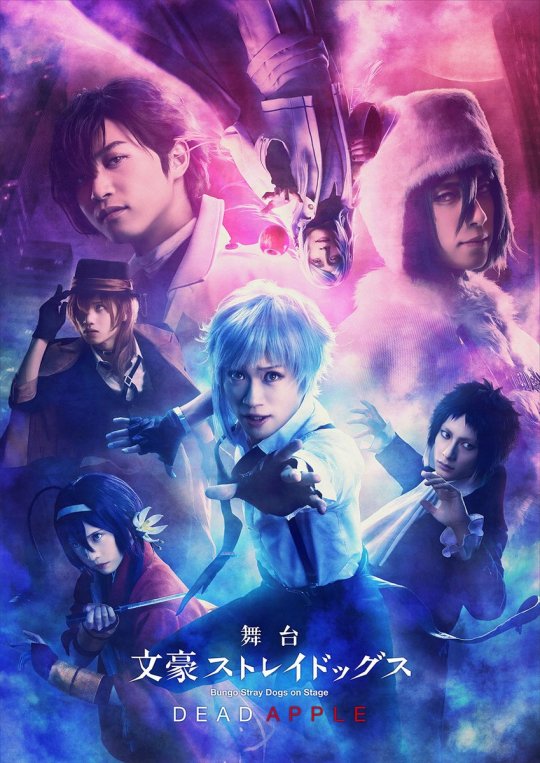

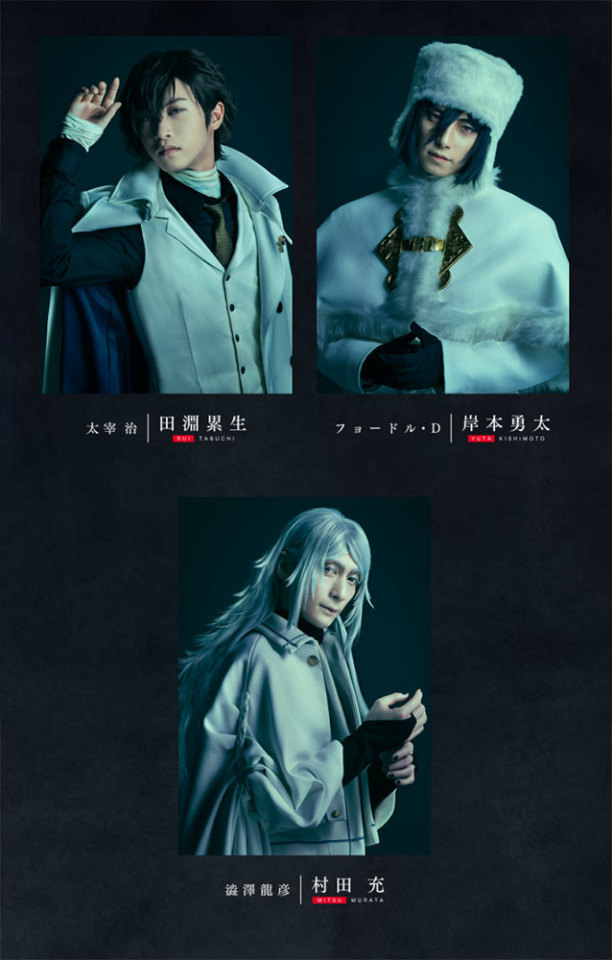
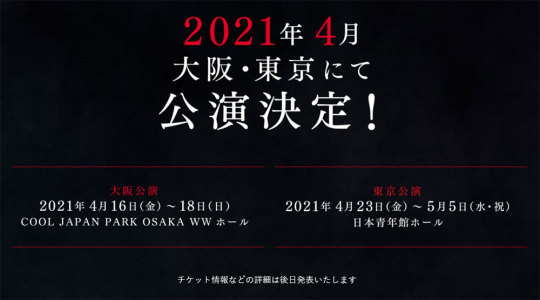
[ STAGE ACTORS/ACTRESS ]
(OLD CASTS)
• Yuki Torigoe as Atsushi Nakajima
• Sakina Kuwae as Kyouka Izumi
• Hashimoto Shohei as Akutagawa Ryūnosuke
• Ueda Keisuke as Nakahara Chuuya
(NEW CASTS)
• Rui Tabuchi as Dazai Osamu
• Kishimoto Yuta as Fyodor D.
• Mitsu Murata as Tatsuhiko Shibusawa
—
sources: twitter & bungo stage
#bungo stray dogs#anime#bungou stray dogs#bungo stray dogs dead apple#bungo stray dogs stage play#bungo on stage#bungo stray dogs dead apple stage play
56 notes
·
View notes
Text
Watch Bungo Stray Dogs BEAST Live-action Film's Intense Ability Battles in New Clips
The official website for Bungo Stray Dogs the Movie BEAST, the first live-action film inspired by the Bungo Stray Dogs manga series created by Kafka Asagiri (story) and Sango Harukawa (arts), has posted three new clips introducing its intense action action scenes.
- The scene where the protagonist Ryunosuke Akutagawa (played by Shohei Hashimoto) overwhelms the members of Port Mafia, using his ability "Rashomon", which creates shadow-like blades from his cloak.
youtube
The scene where Atsushi Nakajima (Yuki Torigoe), Akutagawa's nemesis, transforms into a white tiger with his ability "Gekkaju" (Beast Beneath the Moonlight) and attacks enemy soldiers one after another from the darkness.
youtube
- The scene where Sakunosuke Oda (Kenshi Taniguchi) is engaged in a fierce gun battle using his "Teni Muhou" (Flawless) ability that can predict the future in seconds.
youtube
The film is based on the series' spin-off manga illustrated by Shiwasu Hoshikawa, which is set in a parallel world where the main character, Atsushi Nakajima, and his nemesis, Ryunosuke Akutagawa, belong to opposite organizations. All of the main cast members of the Bungo Stray Dogs stage play series, including Yuuki Torigoe as Atsushi Nakajima and Shohei Hashimoto as Ryunesuke Akutagawa, reprise their roles.
The Koichi Sakamoto (Power Rangers, Heisei Kamen Rider series, Ultraman series)-directed film is set to be released in Japan on January 7, 2022.
Full Trailer:
youtube
Poster visual with a tagline: "The 'beast' inside you will awaken."
Main cast:
Atsushi Nakajima: Yuuki Torigoe
Ryunosuke Akutagawa: Shohei Hashimoto
Gin: Ayaka Konno
Sakunosuke Oda: Kenshi Taniguchi
Doppo Kunikida: Teruma
Rampo Edogawa: Ryoki Nagae
Junichiro Tanizaki: Kosuke Kuwano
Kenji Miyazawa: Hitoshi Horinouchi
Akiko Yosano: Aoi Hirokawa
Naomi Tanizaki: Akari Saito
Osamu Dazai: Rui Tabuchi
Kyoka Izumi: Sakina Kuwae
Chuya Nakahara: Keisuke Ueda
Tatsuhiko Shibuzawa: Mitsu Murata
Fyodor Dostoyevsky: Yuta Kishimoto
Ango Sakaguchi: Hirofumi Araki
Source: "Bungo Stray Dogs the Movie BEAST" official website
©"Bungo Stray Dogs the Movie BEAST" Production Committee
By: Mikikazu Komatsu
5 notes
·
View notes
Photo




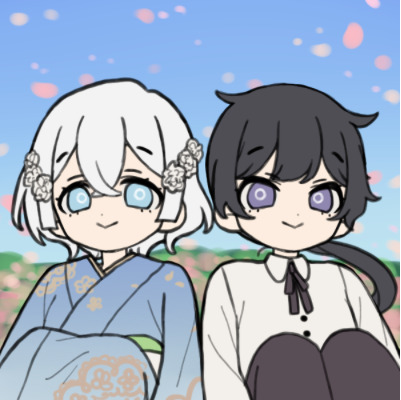
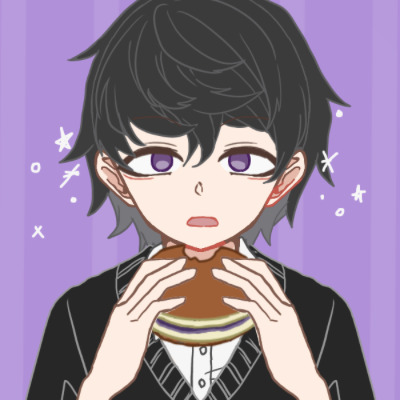



Sooooooo I made a bunch of fankids for my ship with Yukichi Fukuzawa and Mori Ougai......................yeah. Links to the picrews are down below, tagging @teawithsugarships @braveassassins @noellojello and @dokiquents.
x/x/x/x/x/x/x
14 notes
·
View notes
Text
When the Last Sword is Drawn/Music Revolution!! (Yukigumi, 2019)
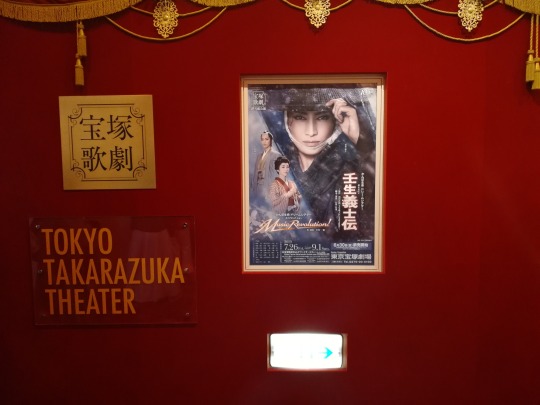
After 6 viewings and the shinko, I'd say I've seen this show a lot. I had high hopes going in, and for the most part, this show met them. The movie is stunning, and the story at its core is heartbreaking. The revue didn’t immediately stun me, but after watching it as many times as I have, it’s really grown on me. Beware for Many Many spoilers within. Also this thing is LONG, it’s a fairly detailed summary and i have a LOT of opinions about this show, this troupe, and the revue.
In brief. Or as brief as I can be with this confusing show. In a framing device, we see a ball at the Rokuemeikan in 1885, attended by a group of high ranking people; Matsumoto Ryoujun (Nagina Ruumi), his wife Toki (Chikaze Karen), and Nabeshima Nagako (Himehana Yukino). It's interrupted by a group of thugs who are swiftly defeated by Police Inspector Saitou Hajime (Asami Jun) and his deputy, Ikenami Rokusaburou (Agata Sen). The doctor and nurse of the Rokuemeikan, Oono Chiaki (Aya Ouka) and his wife, Mitsu (Asazuki Kiwa), come by, and it turns out there is some kind of history between Saitou and Mitsu's long dead father.
(For eases sake, I'll skip commenting on the rest of the transitions, just know they're there at fairly regular intervals. I'll get to my opinions on those soon).
We flash back around 40 years. Yoshimura Kanichirou (Nozomi Fuuto) proposes marriage to Shizu (Maaya Kiho), who, after some teasing, accepts him. They're poor, but happy with each other. She meets Yoshimura's best friend, Oono Jiroemon (Ayakaze Sakina), the lord of their domain, who at one point also wished to marry her. After a short scene with Oono's mother, we skip forward 20 years or so. Yoshimura's mother has just passed, and his son, Kaichirou (Ayami Sera), comes to tell him the news that Shizu has attempted to drown herself. After rushing home, he finds Shizu safe and alive. It comes out she tried to kill herself because she's pregnant again, a third child that they won't be able to feed, they're struggling as it is with the harvests as poor as they are. He'll have to find another way to provide for them, and he resolves to abandon his position as a samurai and join the Shinsengumi in Kyoto.
In Kyoto, we meet the Shinsengumi. The introduce themselves with their theme song (something I have not been able to stop singing). The three most important members are Saitou Hajime, only now with long hair, Hijikata Toshizou (Ayanagi Shou), and Okita Souji (Towaki Sea). They lead the rest of the group in a number excelling how good they are. After some conversation, the group has a photo taken of themselves, one ruined by Tani Sanjuurou (Souno Haruto), a man trying to push his brother to succeed Kondou Isami. He is not popular.
Yoshimura leaves his home, gifted a travel pass to allow him safe passage through the country by Oono. Yoshimura and Shizu sing a duet as they part in the snow, Yoshimura leaving his children and wife behind to ensure they survive another year. Yoshimura swears to return home no matter what and after a really fun song sung by Ai Sumire, he's officially part of the Shinsengumi.
This is one of my favourite scenes in the whole show, it's this chaotic mess of a scene where everyone is doing something fun. Tani is entertaining the crowd, whilst his brother Shuuhei (Manomiya Rui) looks on ashamed. Agachin and Nagakura Shinpachi (Machi Yuuka) are bickering in the background. Yoshimura is running around keeping the sake flowing, and soon sits next to Saitou, who he enthuses about his homeland of Morioka to. Saitou fucking hates him almost instantly. The next scene, Saitou tries to kill him for being a sappy, uneducated, family man from the country, before Yoshimura handily bests him.
The Shinsengumi too, do not approve of Yoshimura. He constantly asks after money, not caring much for propriety, and he doesn’t care much for the senseless violence that most of the Shinsengumi are rather famous for. Back home, we see how Yoshimura’s family is. Shizu, Kaichirou, Mitsu, and the baby have been left in the care of Otora (Satsuki Aina) and Okane (Anno Konnomi), who steal the money Yoshimura sends back. In essence, they’re unhappy, still poor, and often ill. Shizu has to sell a hairpin Yoshimura gave to her in order to pay for the medicine her youngest child needs. All in all, nobody is particularly happy.
Back in Kyoto, Ogawa Shintarou (Kujou Asu), has been accused of theft. Hijikata tries to make Souji, Harada Sanousuke (Tachibana Kou), and Nagakura all take on the role of his second (the person in a seppuku who beheads the one killing himself), but all resist his commands. Saitou argues the one who should act as second should be his division comander, Tani, and Hijikata agrees, but Yoshimura will also aid, given Tani’s reputation. During the seppuku, Ogawa fails to properly cut his stomach open and Tani fails to behead him. After a small scuffle, Yoshimura beheads him (in a truly fantastic bit of design, wherein Asu and Daimon head behind a screen, and by using lighting design, sihlouettes, and sound effects, it genuinely does look like a beheading). Many of the Shinsengumi call for Tani’s death, but as personal disputes are banned in the Shinsengumi, Kondou puts a stop to this. Saitou is not happy. Yoshimura begs Hijikata for more money, and after he leaves, Saitou comes onstage to tell Okita, Harada, and Nagakura his plan to eliminate the man they all hate. Some members of the Shinsengumi have defected, and during a fight they know will be happening soon, they can take advantage of the confusion to execute him and pass his death off as casualty in battle.
After a brief interlude in Morioka, where we hear that Oono is moving to Osaka with his family, and that by and by, Yoshimura’s family are doing well, we come to the Aburakouji incident. Kondou and the Shinsengumi ambush Itou Kashitarou (Kiraha Reo) and Toudou Heisuke (Suwa Saki), who are attempting to asssasinate Kondou. After a scuffle, Yoshimura excecutes both Itou and Toudou, and soon after Saitou assasinates Tani. This leads to my favourite encounter in the whole play, wherin Nagakura and Harada “discover” Tani’s body. They comically overact the whole thing, and Okita and Saitou make some snide comments about how bad of a pair of actors they are.
Following this, we’re introduced to Miyo (also Maaya Kiho), the daughter of the family hosting the Shinsengumi in Kyoto, who’s been in love with Yoshimura for years and wishes to marry him. She wants to convince Kondou and Hijikata to let Yoshimura leave the Shinsengumi and lead a peaceful life.
Saitou comes across Yoshimura investigating the body of Tani, and Yoshimura quite deftly points out that there’s no way Tani could have died in the brawl, and that the only person who could have assasinated him was Saitou (Saitou wields a sword with his left hand, and the wound was inflicted by a left hander). Yoshimura blackmails Saitou into paying him off, and walks away twenty ryou richer. Shuuhei comes on, desperately screaming at the murder four (Saitou, Okita, Nagakura, and Harada) to bring his brother back. Hijikata pays Saitou back the twenty ryou he paid to Yoshimura.
After another of the framing device sections, we come to the marriage interview between Yoshimura and Miyo, Yoshimura clearly completley distressed by the whole affair but too terrified of losing his position to say anything. Hijikata and Kondou speak of their plans to let Yoshimura divorce Shizu, and to leave the Shinsengumi. Yoshimura cannot find the words to reject them, but Ikenami steps in and tells them all how they don’t understand the pains of the common people. Yoshimura slaps him, hugs him, and then leaves, followed by Miyo, who he waxes lyrical to about his wife. This leads into a beautiful tanbata scene, where Yoshimura allows himself for just a second to indulge in hugging Miyo, before the guilt gets the better of him and he runs off.
The people of Kyoto and Oono’s forces in Osaka sing of the troubling times as the Shinsengumi begin their march to Osaka, ending as the curtain rises on the thoroughly beaten and bruised Shinsengumi. After some time, Hijikata orders a retreat which Yoshimura rejects, leading a suicide attack on the government’s forces, during which he is shot and stabbed. He makes his way to his clan’s storehouse, to get permission to return to Morioka to be with his family, and meets Oono there. Oono, bound by his duty, orders him instead to commit seppuku, which he does, after a truly heartwrenching sequence in which Yoshimura counts the money he was going to spend on things for his family. His sword and hair are brought back to his family, and his son resolves to fight alongside Oono in the upcoming conflict. Both die in battle, with Oono dying heartbreakingly so onstage.
We return to the framing device, where the Meiji players contemplate what kind of man Yoshimura was. Ryoujun leads a reprise of Yoshimura and Shizu’s duet, which they take over, as the whole troupe joins in and cherry blossoms finally bloom.
I loved this show a whole lot. A whole whole WHOLE lot. My tastes lie deep in “tragic nihonmono that don’t involve a lot of politics,” “Nozomi Fuuto as a dad,” and “Agata Sen having just The Best Time.” I got all three in SPADES. This show is a character driven one, in my eyes, with the core conflict being internal. Yoshimura does arguably terrible things to keep himself afloat, and to keep providing for his family, and all the while daimon ACHES with this need to return home. Whenever given the chance, he waxes lyrical about how much he loves his homeland, his family, and especially his wife. When dying, the last words he speaks are his wife’s name. Yoshimura loves his family more than anything else in the world and it comes through with literally everything Daimon does. The tragedy is clear from the start, and once the last 15 minuites or so start you know there’s only one ending. But there’s even more beautiful tragedy that I can’t bring myself to spoil that just makes everything worse, more painful.
My biggest issue with the show is the framing device. Whilst I don’t mind it too much, I know others hate it a LOT more than I do, and I get why. Every so often, the Rokumeikan crew will walk along the ginkyo or across the stage and exposit about where certain people were at certain points, and it did have the effect of completely breaking the flow of action and tension. Hime and Agachin stand out as the MVPs of those scenes, but Agachin was only in a few of them and Hime can only do so much alone. I didn’t hate them, but I do get why one might.
Nozomi Fuuto as Yoshimura Kanichirou was fucking fantastic, genuinely one of the best performances i’ve ever seen her bring. She has the unenviable task of delivering a really nuanced, sad character whilst also speaking perfectly in a very strong accent, and does it without breaking a sweat. I don’t have enough good things to say about her accent, by the way. I feel like it could be a touch controversial, and it does make her impossible to understand (my Japanese friends agreed, it’s a HARD one), but it adds so much to her character. Daimon’s face was designed to look good when sad, and this show is no exception, she has a kind of mastery over these faces that just ache lonliness like nobody else in the world does. Her voice as she’s dying is so broken, these little gasps of pain are just sublime and her voice as she’s counting out the coins she’s earned over her six years is so beautifully sad. Her performance is exceptional in how subtle it is. She doesn’t bring anything big or ballistic to the table, she just tries to create a picture of this man desperate to do what’s right for his loved ones and to his own code of honour to the table. His last moments are so desperaetly sad because you know full well he regrets everything he’s done to get there, and in the same breath knows it’s his supposed duty as a samurai to have done what he did. Yoshimura is a hard role and Daimon made him look easy, and carried off the accent too. I can’t imagine anyone else in this role.
Maaya Kiho played two roles in this, and I fucking loved them both. I will say, I wish her role as Shizu had been given a little more weight, but I loved Miyo enough that I can’t stay too angry. She plays Shizu at two points in her life, first young and giddy in love, and then older, married, a mother, and far far more tired. As that younger Shizu she plays her with such life, her Shizu is teasingly affectionate to Yoshimura, but clearly in love with him. On my last performance I noticed that during her first scene, before Yoshimura proposes to her, she’s fixing up her hair and kimono, making herself look as pretty as she can. It’s adorable. As the older Shizu she carries this utter grace with her, world weary and hard done by. Her and Daimon have amazing chemistry together, they play this old married couple so well, both softly amused by their children even when it’s their last moments together. Her maturity is so quiet, so calm, and it’s another half of these two incredibly subtle performances the top combi give. As Miyo she’s a bratty selfish teenager, and it’s her earlier maturity as Shizu that makes Miyo even more entertaining. She’s selfish in that way only spoiled kids are, saying she’s completely in love with Yoshimura when she’s barely shared a conversation with him, and acting as if he’d be perfectly willing to abandon his whole family to marry her. It’s not the biggest role but she imbues it with such grace and charm I can’t help but adore it.
Ayakaze Sakina was unfortunately typecast again as the best friend, and it’s absolutely detremential to her. Oono, in my eyes, is just straight up not an interesting character. His major role is acting as the exposition dumper, and his few scenes of humanising moments don’t work for me like they should because I don’t buy him as a character properly. I want Saki to get a good, interesting role that forces her out of her shell as just the best friend and I’m annoyed she didn’t get it here.
Asami Jun was the nibante, to be frank. Her Saitou was gruff and angry and simmering with barely restrained loathing for Yoshimura, and I fucking loved it. It didn’t blow me away like I think that role could have but Aasa I think tried her damn hardest, biting onto what she got given and trying with all her might. The relationship between Yoshimura and Saitou didn’t land quite as it could have, and I can’t blame all of that on the writing (only a decent chunk of it). Aasa’s Saitou hated Yoshimura too much, which I think made her sudden face turn at the end of the play towards sympathy to Yoshimura feel a little flat, but I’ll be honest, I wasn’t really looking at her during that scene at all (and we’ll get to why soon).
Shou is still our sanbante but it’s entirely in name only at this point. Hijikata is a tiny role, she gets to sit and scowel, and grumble “Mendoksei, mendoksei” at the murder four, and it’s just. Not interesting. And I so wish it was, because I love Shou. She’s quietly endeared, to my eyes, by their nonsense, which I think was perhaps more of Shou than the role, but it was rather fun all the same.
Towaki Sea got a role on the smaller end too, but definitely one bigger than Shou. Okita Souji is a fun role, a violent shitty dude, but also a really fun genki one. Her and Aasa have a really fun dynamic together, really fed up with the bullshit of everyone around them, especially from Yoshimura and Tani, who they hate for very different reasons. Her adlibs with Aasa, Macchi, and Tachi were really fun, and she really played the heart of that group, if a very violent angry one. I don’t know what I CAN say about her Souji, though, because he wasn’t the biggest role in the world. What I can say is that Hitoko is putting her heart and soul into everything, even moreso than I think she was in mura, what with the looming transfer and all.
Aya Ouka was… I don’t think she’s tracked any more. On paper she has a role the same size as Agachin’s but whilst Agachin was taking what she was given and running with it, Ayana was projecting at a brick wall. Ayana played Chiaki, Oono’s son, who I think could have acted as another half of the emotional core of the story, but it would have required a damn sight more than what Ayana was giving. I don’t want to be too harsh on her, but she just wasn’t bringing anything at all to the show. The script wasn’t amazing towards her but I think she well could have made something of it. I know this, because…
Agata Sen fucking DID. I have fallen completely and utterly head over heels with Agata Sen and anyone who knows me knows that fact but I am writing this with as little bias as I can be (but I WAS watching her with opera glasses for literally every show so like. Only so much). Ikenami Rokusaburou also wasn’t a huge role on paper, and could well have been boring and forgettable but Agachin did SO MUCH for it. Ikenami is one of the only survivors of the Shinsengumi, and ends up a police inspector with Saitou. She’s present in the Shinsengumi scenes and ends up forming a very sweet bond with Yoshimura in the process, going from actively antagonising him (with the aim of sucking up to Kondou) to defending him in a really lovely scene, calling out the bullshit of Kondou and Hijikata, and how they just don’t get the struggles of common people. Her line delivery of her speech to Kondou and Hijikata told a story without saying any of it, and it’s absolutely fantastic. And she’s the fucking BEST in the background, I know full well the blu-ray won’t capture any of it but every single day she and Macchi were pulling out new types of bullshit and I think Macchi is going to kill her sometime soon. I love her so very much and she’s going to be Something very very soon. Just you wait.
Kacha was. There. Completely irrelevant and doing nothing for the plot, just awkwardly hanging around during the Rokumeikan scenes. I don’t think anyone enjoyed this role, she didn’t actually DO anything, and I took particular insult to her starting off the finale because there was no emotional reason for her to do so! I didn’t like this role and I can’t imagine her die hard fans did either.
Other people of note
Mana Harutou was a really fun Kondou, playing him as a rather useless leader, stuck in indecision and almost inept at points. It was a nice role, and I hope she keeps getting roles like this, not enormous, but still big. She’s one of my favourites.
Kiraha Reo is still playing two roles in a show (though only one of them matters) and I can’t help but laugh. Itou isn’t the biggest role either, but she gives him a decent amount of depth, clearly holding some resentment towards the Shinsengumi from the start, and dripping with loathing as they take him and his rebellion out.
Kujou Asu gets the worst role of the lot, a nothing samurai who has to commit seppuku and fails terribly at it, but she has a lot of fun running around with her hair loose, covered in blood.
Souno Haruto, our new Kumichou, also having the time of her life as the comedic side relief Tani Sanjuurou. Every day during one scene she’d force Manaharu into a love suicide and every day it had me quietly losing my SHIT. She’s the best.
I’ve wanted better things for Ai Sumire for the longest time and so hearing her get a solo in this? Thank the LORD. she’s a great singer and it’s great we’re using her more.
I just really like Manomiya Rui, y’all? She has the friendliest otome picture and her energy is so nice. She was fun as Shuuhei.
Tachibana Kou and Macchi Yuuka were my absolute favourite part of this show by a country MILE. Comedic side relief and vicious killers all at once. I can’t wait to see how absolutely awful their fake acting gets by raku.
Music Revolution grew on me. It’s a Nakamura revue and it is, to its core, a Nakamura revue, but in my eyes it’s one of his best. Not just because of copious amounts of Agachin but good GRIEF she is a spectacular dancer and this revue shows that off.
The theme song is a complete banger, black and dark grey outfits and some really genuinely tight choreography from Yukigumi. Daimon’s voice could fill the whole theatre without a microphone and so could Kiichan’s and they absolutely owned the show. Daimon seems absurdly full of energy, and it’s REALLY nice to see her leading the troupe having so much fun at the same time. Everyone on the track gets a little moment, even down to Agachin and Ayana, and I can’t help but feel an enormous amount of pride for the whole troupe. I love them, they feel like home so very much.
The revolution scene fucking OWNS. Daimon leads a group of argentinian revolutionaries against the forces of the British army and comes out on top. Everyone’s singing at 200%, especially Maaya motherfucking Kiho, and dancing in really tight formation. They look and sound amazing. Aasa and Hitoko lead the British forces and they also look DAMN good in those red uniforms, and dance REAL good too. I would say it’s my favourite number of the revue but practically every number is, so.
Then comes your standard Nakamura B jazz number, led by Saki with Agachin and Ayana behind her. It’s a really fun couple minutes, just the whole troupe leaping around and dancing, culminating in a fake music duel between Agachin on the trumpet and Ayana on the saxaphone, and it’s super fun! Agachin does this flying leap every day and it’s fucking fantastic, I love watching her dance. Aki and Hime get a duet (a reoccuring feature, and not one I’m mad about, they’re really fun together), and it’s just a really good time.
The chuuzume I couldnt love more. It goes on forever and yet every single kangeki I was sitting in my seat BEAMING when Aasa starts singing and neon lights blast, it was so fun. It goes from one extreme to another with lightining speed, and yukigumi moves in absolute harmony, and it’s just. Great. Every day Daimon, Kiichan, Kacha, Saki, Aasa, and Hitoko find new nonsense to do on the ginkyou as the rest of the troupe goes into the aisles and it’s just such a warm feelgood time I can’t help but be happy watching it.
Hitoko gets a really fun little number, to fucking Pachabel’s Canon, which I went in expecting to hate (as a musician i’ve heard that damn song too many times) but ended up loving (I’m a sucker for electric guitars). Following the transfer announcement the amount of applause Hitoko got for this scene skyrocketed and that’s something I can’t help but love. She’s an excellent dancer (not that i’d know it. Agachin was in that scene. I was looking at her literally every single time).
Inexplicably Nakamura decided to add in a taidan number for Daimon and Kiichan, though I suppose the real taidan is for Hitoko’s heart (poor dear is already starting to crack and will absolutely be a wreck by raku). It’s fun and catchy and it’s nice to see the remaining 89ths have fun together, and for Daimon and Kiichan to just be completely nerdy.
We finally, after two years, have a Daimongumi kuroenbi and it’s absolutely fantastic. Everyone looks stellar in tailcoats, we dance with precicion and order and Daimon sings like nobody’s business. They look good, they sound good, and it’s just. The best.
I adore the duet dance. Daimon and Kiichan gently dance whilst Ai Sumire sings and it’s just overall really really nice. It’s almost ethereal, purple outfits and a shit ton of smoke and Daimon and Kiichan clearly just. Adore each other. Their freindship is clearly so strong and sweet and they really suit each other.
I loved this whole show. Whilst I think I prefer Hikarifuru as a show, this takes the cake for my favourite pairing of shows. They’re both super strong and I can’t help but love the shit out of them. Daimon and Kiichan’s chemistry feels so easy and comfortable, two people who just Get Each Other, and it’s so nice to see them play off each other. I wish Kiichan had more to do, but like. She deserves everything. Fingers crossed our next revue does right by her (please give us an Uekumi revue i’m BEGGING you).
#takarazuka#yukigumi#nozomi fuuto#maaya kiho#ayakaze sakina#my reviews#this is long and not proofread and goes from highly analytical to me crushing on agata sen you cannot make me change or stop#also dont read if you dont want spoilers for this show ajdknjasd it is spoiler heavy
26 notes
·
View notes
Photo

[Announcement] 舞台「文豪ストレイドッグス DEAD APPLE」 (butai bungou stray dogs dead apple)
you will be able to watch 16 shows @ Streaming+ & PIA LIVE STREAM
price: ¥2.500 + fees (each)
◎ April 23rd, 2021 ~ 18:00
◎ April 24th, 2021 ~ 13:00
◎ April 24th, 2021 ~ 18:00
◎ April 25th, 2021 ~ 13:00
◎ April 26th, 2021 ~ 18:00
◎ April 27th, 2021 ~ 13:00
◎ April 27th, 2021 ~ 18:00
◎ April 28th, 2021 ~ 18:00
◎ April 30th, 2021 ~ 18:00
◎ May 1st, 2021 ~ 13:00
◎ May 1st, 2021 ~ 18:00
◎ May 2nd, 2021 ~ 13:00
◎ May 3rd, 2021 ~ 18:00
◎ May 4th, 2021 ~ 13:00
◎ May 4th, 2021 ~ 18:00
◎ May 5th, 2021 ~ 13:00
[archive will be available for a week]
!!each stream comes with a (different) tokuten-bromide!!


#文豪ストレイドッグス#bungou stray dogs#bungo stray dogs#鳥越裕貴#torigoe yuuki#桑江咲菜#kuwae sakina#橋本祥平#hashimoto shouhei#植田圭輔#ueda keisuke#田淵累生#tabuchi rui#岸本勇太#kishimoto yuuta#村田充#murata mitsu#大石樹#ooishi itsuki#岡村樹#okamura tatsuki#山中啓伍#yamanaka keigo#有光麻緒#arimitsu mao#浦島優奈#urashima yuuna#小野塚茉央#onotsuka mao#小林らら
22 notes
·
View notes
Text
J-Birthday List (Updated 16.07.19)
01.01 -Ice (Ex. Xodiack / Ex. Black Gene For The Next Scene/ solo-musician)
05.01 -Miku (Ex. An Cafe)
07.01 -Tsubasa (XOX)
08.01 - Daisuke (Ex. Roach/ Jupiter)
19.01 -Keiji (Mix Speaker’s,inc.)
20.01 -Aoi (The GazettE)
20.01 -Rui (Ex. SCREW/ now Solo-musician)
24.01 -Yuta (IVVY)
29.01 -Kyary Pamyu Pamyu
29.01 -Shota (BLACK IRIS)
29.01 -Reo (SUPER DRAGON)
01.02 -Ruki (The GazettE)
07.02 -Miki (Mix Speaker’s,inc.)
08.02 -Joonho (JOONHO&GYUMIN)
09.02 -Takuya (Ex. An Cafe)
09.02 -Yuta (XOX)
12.02 -Kazumasa (XOX)
15.02 -Rio (BLACK IRIS)
16.02 -Reon (Ex. RoNo☆Cro)
17.02 -Hizaki (Versailles/ Jupiter)
17.02 -Sougo (SUPER DRAGON)
18.02 -Yuki (Ex. Jupiter/ Versailles)
18.02 -Ren (Danger Gang)
21.02 -Tatsuki (FlowBack)
26.02 -Sorao (Ex.THE KIDDIE)
27.02 -Tsuyoshi (SUPER DRAGON)
27.02 -Koki (SUPER DRAGON)
07.03 -Miko (Exist Trace)
20.03 -Omi (Exist Trace)
20.03 -Shinpei (Ex. SuG)
25.03 -Ryohei (Megamasso)
01.04 -Judai (FlowBack)
02.04 -Chisa (Ex. Nexx/Ex. DIV/ ex. Chisa&Shogo/ ACME )
09.04 -Yusa ( Ex. THE KIDDIE/ Guts and Death)
10.04 -Teru (Versailles/ Jupiter)
10.04 -Jyou (Exist Trace)
12.04 -Lin (MADKID)
15.04 -Tomoya (SUPER DRAGON)
15.04 -Hal (ACME)
16.04 -Rucy (Ex. Killaneth/ Ex. Jupiter)
17.04 -Taka (ONE OK ROCK)
23.04 -Tsubame (BugLug)
25.04 -Masashi (Ex. Jupiter/ Verasailles)
25.04 -San (Ex. Nega/ Ex. Black Gene For The Next Scene/ Lack-co)
28.04 -Reiji (FlowBack)
28.04 -Raku (SUPER DRAGON)
04.05 -Hiroto (Alice nine)
05.05 -Jean (SUPER DRAGON)
07.05 -Issei (BugLug)
11.05 -Takeru (SuG)
13.05 -Taiyu (IVVY)
13.05 -Waka (Danger Gang)
15.05 -Mark (FlowBack)
20.05 -Masaharu (FlowBack)
23.05 -Riku (XOX)
26.05 -Masato (SuG)
27.05 -Shalf (BUZZ-ER)
27.05 -Reita (The GazettE)
01.06 -Gyumin (JOOHNO&GYUMIN)
02.06 -Hyoma (SUPER DRAGON)
04.06 -Hiroto (IVVY)
07.06 -Yuko (Wagakki Band)
09.06 -Uruha (The GazettE)
09.06 -Kento (IVVY)
23.06 -Manabu (Ex. SCREW)
11.06 -Rame (Ex. Vidoll/ Ex. Black Gene For The Next Scene)
15.06 -Youta (MADKID)
24.06 -Saga (Alice nine)
27.06 -Tomoya (ONE OK ROCK)
30.06 -Jui (Ex. Vidoll/ Gotcharocka)
03.07 -Yukihisa (Ex. Yeti)
03.07 -Hiro (BLACK IRIS)
04.07 -Gackt
05.07 -Shou (Alice nine/ DIAWOLF)
05.07 -Kanon (Ex. An Cafe)
08.07 -Takuya (BLACK IRIS)
13.07 -Yuya (BUZZ-ER)
18.07 -Setsuki (Ex. RoNo☆Cro)
19.07 -Kohey (BUZZ-ER)
19.07 -Kamijo (Versailles/ solo-musician)
21.07 -Sadao (XOX)
21.07 -Kazuki (MADKID)
22.07 -Jin ( Ex. SCREW)
27.07 -Yuki (MADKID)
28.07 -S (Mix Speakers,inc.)
30.07 -Maya (LM.C)
30.07 -Rayto (Ex. GRiT/ BLACK IRIS)
31.07 -Nao (Alice nine)
04.08 -Jun (Ex. THE KIDDIE)
05.08 -Kazuki (Ex. SCREW)
05.08 -Batoshin (XOX)
08.08 -Takumi (Ex. v[NEU])
11.08 -Toya (Ex. Charlotte/ Gotcharocka)
17.08 -Sala (Ex. Black Gene For The Next Scene)
29.08 -Yuki (Ex. An Cafe)
01.09 -Zin (Jupiter/ solo-musician)
04.09 -Ryota (ONE OK ROCK)
05.09 -Shogo (Ex. xTRIPx/ Ex. DIV/ Ex. Chisa&Shogo/ ACME)
13. 09 -Machiya (Wagakki Band)
14.09 -Miyavi
14.09 -Toman ( Ex. XOX)
17.09 -Tora (Alice nine/ DIAWOLF)
19.09 -Takanori Nishikawa (T.M.Revolution)
20.09 -Namie Amuro
24.09 -Ban (Ex. Loud Grape/ Ex. Lolita23q)
24.09 -Ryuuji (Ex. Zoro)
02.10 -Shin (MADKID)
02.10 -Ayumi Hamasaki
03.10 -Shin (MADKID)
05.10 -Naoto (Exist Trace)
09.10 -Rikito (ACME)
09.10 -Satoshi (Ex. DIV/ Laplus)
12.10 -Hayate (SUPER DRAGON)
15.10 -Bikkey (Yeti)
17.10 -Kazuki (BugLug)
19.10 -Toki (Ex. Black Gene For The Next Scene)
21.10 -Yuji (Ex. SuG)
21.010 -Chiba (BUZZ-ER)
25.10 -Yui Itsuki (Yousei Teikoku)
26.10 - Mello (Ex. RoNo☆Cro)
28.10 -Kai (The GazettE)
29.10 -Saku (BUZZ-ER)
05.11 -Wasabi (Wagakki Band)
09.11 -Minami (Ex. Vurny/ Ex. RoNo☆Cro)
11.11 -Mitsu (Ex. v[NEU]/ solo-musician)
13.11 -Koda Kumi
13.11 -Satoshi (Ex. Aicle/ Yeti)
14.11 -Hau (BUZZ-ER)
17.11 -Jun (Ex. Phantasmagoria/ Ex. Spiv States/ Gotcharocka)
17.11 - Aiji (LM.C)
26.11 -Kayuu (Ex. v[NEU])
27.11 -Mally (Exist Trace)
01.12 -Kiyoshi (Wagakki Band)
04.12 -Chobi (Ex. xTRIPx/ Ex. DIV)
07.12 -Toru (ONE OK ROCK)
08.12 -Teruki (Ex. An Cafe)
10.12 -Hiko (Danger Gang)
18.12 -Asa (Wagakki Band)
19.12 -Toshiki (IVVY)
21.12 -Yuudai (Ex. THE KIDDIE/ Guts and Death)
26.12 -Shingo (Ex. Gotcharocka)
27.12 -Chiyu (Ex. SuG)
#XOX#Wagakki Band#BUZZ-ER#ONE OK ROCK#The GazettE#Danger Gang#An Cafe#SuG#Gotcharocka#IVVY#MADKID#BLACK IRIS#Yeti#Exist Trace#Yousei Teikoku#Jupiter#Versailes#ACME#Alice nine#Diawolf#LM.C#Mix Speaker's Inc.#Namie Amuro#Koda Kumi#Ayumi Hamasaki#T.M.Revolution#JOONHO&GYUMIN#SUPER DRAGON#FlowBack#Kyary Pamyu Pamyu
40 notes
·
View notes
Text
In Wii Sports, Wii Sports Resort, and Wii Sports Club, there consists of a wide variety of CPU Miis that use different right-handed and left-handed settings for various games. Some Miis only use their right hand, some only use their left hand, and some use both their right and left hand, depending on the game (these Miis are ambidextrous). Here is a list of all the Miis in Wii Sports, Wii Sports Resort, and Wii Sports Club, along with which category they fall under involving handedness. Miis that originally appeared in Wii Sports Club will be noted appropriately.
There are 100 Miis who are right-handed. Here they are, in alphabetical order:
Abe
Adrien (Wii Sports Club)
Akira (Wii Sports Club)
Alex
Alice (Wii Sports Club)
Asami
Ashley
Barbara
Barbara (Wii Sports Club)
Barry (Wii Sports Club)
Bernardo (Wii Sports Club)
Bo-Jia (Wii Sports Club)
Carlo (Wii Sports Club)
Chris
Chris (Wii Sports Club)
Claudia (Wii Sports Club)
Cole
Christina (Wii Sports Club)
David (Wii Sports Club)
Delilah (Wii Sports Club)
Dunbar (Wii Sports Club)
Dylan (Wii Sports Club)
Eddy
Eduardo
Eduardo (Wii Sports Club)
Elena (Wii Sports Club)
Erick (Wii Sports Club)
Faustine (Wii Sports Club)
Frank (Wii Sports Club)
Fritz
Gabi
George
Gerald (Wii Sports Club)
Greg
Guillermo (Wii Sports Club)
Haixiang (Wii Sports Club)
Haruka (Wii Sports Club)
Hiromasa
Hiromi (Wii Sports Club)
Holly
Ilka (Wii Sports Club)
Irina (Wii Sports Club)
Jake
Jeff (Wii Sports Club)
Jesús (Wii Sports Club)
Jialan (Wii Sports Club)
Jin-ah (Wii Sports Club)
Joana (Wii Sports Club)
John (Wii Sports Club)
Joost (Wii Sports Club)
João (Wii Sports Club)
Julie
Kaori (Wii Sports Club)
Kazuhiko (Wii Sports Club)
Kentaro (Wii Sports Club)
Marie (Wii Sports Club)
Marit (Wii Sports Club)
Marius (Wii Sports Club)
Mark (Wii Sports Club)
Massimo (Wii Sports Club)
Matt (Wii Sports Club)
Maximilian (Wii Sports Club)
Mia
Midori
Mike
Mónica (Wii Sports Club)
Na-rae (Wii Sports Club)
Nelly
Pablo
Patricia (Wii Sports Club)
Patrick
Paula (Wii Sports Club)
Pit (Wii Sports Club)
Polly (Wii Sports Club)
Ren
Ricardo (Wii Sports Club)
Rie (Wii Sports Club)
Rui-Lin (Wii Sports Club)
Sandra
Se-young (Wii Sports Club)
Sho (Wii Sports Club)
Shu-Hui (Wii Sports Club)
Silke
Siobhán
Sota
Steph
Steve
Susana
Takashi
Takumi
Tatsuaki
Tommy
Tomoko
Tyrone
Víctor
William (Wii Sports Club)
Xiaojian (Wii Sports Club)
Xixi (Wii Sports Club)
Yoshi
Yunyun (Wii Sports Club)
Zi-Kai (Wii Sports Club)
There are 66 Miis who are left-handed. Here they are, in alphabetical order:
Alisha
Alphonse (Wii Sports Club)
André (Wii Sports Club)
Anna (Wii Sports Club)
Anne (Wii Sports Club)
Araceli (Wii Sports Club)
Bernd (Wii Sports Club)
Bowen (Wii Sports Club)
Bruce (Wii Sports Club)
Cheng-Han (Wii Sports Club)
Chika
Clara (Wii Sports Club)
Daisuke (Wii Sports Club)
Donna (Wii Sports Club)
Emma
Enrique (Wii Sports Club)
Gabriele
Giovanna
Giulia (Wii Sports Club)
Gwen
Hee-joon (Wii Sports Club)
Hiromi
Ian
Ivo (Wii Sports Club)
Ji-hoon (Wii Sports Club)
Jianjun (Wii Sports Club)
Joseph (Wii Sports Club)
José (Wii Sports Club)
Juliette (Wii Sports Club)
Laura (Wii Sports Club)
Leonel (Wii Sports Club)
Léonie (Wii Sports Club)
Maria (Wii Sports Club)
Marisa
Masako (Wii Sports Club)
Matt
Megan
Merrick (Wii Sports Club)
Mi-sun (Wii Sports Club)
Miguel
Millie (Wii Sports Club)
Mitsu (Wii Sports Club)
Mizuho (Wii Sports Club)
Olga (Wii Sports Club)
Pavel (Wii Sports Club)
Pedro (Wii Sports Club)
Pian-Pian (Wii Sports Club)
Rainer
Rui (Wii Sports Club)
Sara (Wii Sports Club)
Sarah
Shinta
Shohei
Skip (Wii Sports Club)
Sophia (Wii Sports Club)
Steven (Wii Sports Club)
Stéphanie
Susie (Wii Sports Club)
Ursula
Victor (Wii Sports Club)
Vincenzo
Xiao-Tong (Wii Sports Club)
Xuiping (Wii Sports Club)
Xue-Ren (Wii Sports Club)
Yuehua (Wii Sports Club)
Yuriko (Wii Sports Club)
There are 42 Miis who are ambidextrous. Here they are, along with which games they are left-handed in, and which games they are right-handed in. Note that there are no Miis that originated from Wii Sports Club that are ambidextrous.
Abby:
Left-handed in Tennis, Table Tennis, and Baseball (batting)
Right-handed in Baseball (pitching)
Ai:
Left-handed in Tennis
Right-handed in Baseball (batting, pitching) and Table Tennis
Akira:
Left-handed in Tennis and Baseball (batting)
Right-handed in Baseball (pitching) and Table Tennis
Andy:
Left-handed in Tennis and Table Tennis
Right-handed in Baseball (batting, pitching)
Anna:
Left-handed in Tennis
Right-handed in Baseball (batting, pitching) and Table Tennis
Daisuke:
Left-handed in Tennis and Baseball (batting, pitching)
Right-handed in Table Tennis
David:
Left-handed in Tennis
Right-handed in Baseball (batting, pitching) and Table Tennis
Elisa:
Left-handed in Table Tennis
Right-handed in Tennis and Baseball (batting, pitching)
Emily:
Left-handed in Tennis and Baseball (pitching)
Right-handed in Table Tennis and Baseball (batting)
Eva:
Left-handed in Tennis and Baseball (batting, pitching)
Right-handed in Table Tennis
Fumiko:
Left-handed in Tennis and Baseball (batting, pitching)
Right-handed in Table Tennis
Haru:
Left-handed in Tennis and Table Tennis
Right-handed in Baseball (batting, pitching)
Hayley:
Left-handed in Table Tennis
Right-handed in Tennis and Baseball (batting, pitching)
Helen:
Left-handed in Baseball (batting)
Right-handed in Tennis, Baseball (pitching), and Table Tennis
Hiroshi:
Left-handed in Table Tennis
Right-handed in Tennis and Baseball (batting, pitching)
Jackie:
Left-handed in Tennis
Right-handed in Baseball (batting, pitching) and Table Tennis
James:
Left-handed in Tennis and Table Tennis
Right-handed in Baseball (batting, pitching)
Jessie:
Left-handed in Table Tennis
Right-handed in Tennis and Baseball (batting, pitching)
Kathrin:
Left-handed in Tennis and Table Tennis
Right-handed in Baseball (batting, pitching)
Keiko:
Left-handed in Table Tennis and Baseball (batting)
Right-handed in Tennis and Baseball (pitching)
Kentaro:
Left-handed in Tennis, Table Tennis, and Baseball (pitching)
Right-handed in Baseball (batting)
Luca:
Left-handed in Tennis and Baseball (batting, pitching)
Right-handed in Table Tennis
Lucía:
Left-handed in Table Tennis
Right-handed in Tennis and Baseball (batting, pitching)
Marco:
Left-handed in Table Tennis
Right-handed in Tennis and Baseball (batting, pitching)
Maria:
Left-handed in Tennis and Baseball (batting)
Right-handed in Baseball (pitching) and Table Tennis
Martin:
Left-handed in Baseball (batting, pitching)
Right-handed in Tennis and Table Tennis
Michael:
Left-handed in Tennis and Table Tennis
Right-handed in Baseball (batting, pitching)
Misaki:
Left-handed in Table Tennis
Right-handed in Tennis and Baseball (batting, pitching)
Miyu:
Left-handed in Table Tennis
Right-handed in Tennis and Baseball (batting, pitching)
Naomi:
Left-handed in Baseball (batting, pitching) and Table Tennis
Right-handed in Tennis
Nick:
Left-handed in Tennis
Right-handed in Baseball (batting, pitching) and Table Tennis
Oscar:
Left-handed in Table Tennis
Right-handed in Tennis and Baseball (batting, pitching)
Pierre:
Left-handed in Tennis and Table Tennis
Right-handed in Baseball (batting, pitching)
Rachel:
Left-handed in Tennis
Right-handed in Baseball (batting, pitching) and Table Tennis
Rin:
Left-handed in Tennis and Baseball (batting, pitching)
Right-handed in Table Tennis
Ryan:
Left-handed in Tennis and Table Tennis
Right-handed in Baseball (batting, pitching)
Saburo:
Left-handed in Tennis and Baseball (pitching)
Right-handed in Baseball (batting) and Table Tennis
Sakura:
Left-handed in Baseball (batting, pitching)
Right-handed in Tennis and Table Tennis
Shinnosuke:
Left-handed in Baseball (batting, pitching) and Table Tennis
Right-handed in Tennis
Shouta:
Left-handed in Tennis and Table Tennis
Right-handed in Baseball (batting, pitching)
Theo:
Left-handed in Tennis
Right-handed in Baseball (batting, pitching) and Table Tennis
Yoko:
Left-handed in Tennis
Right-handed in Baseball (batting, pitching) and Table Tennis
10 notes
·
View notes
Text
Nampō Roku, Book 4 (23.2): Six Arrangements for the Chigai-dana [違棚], Part 2.

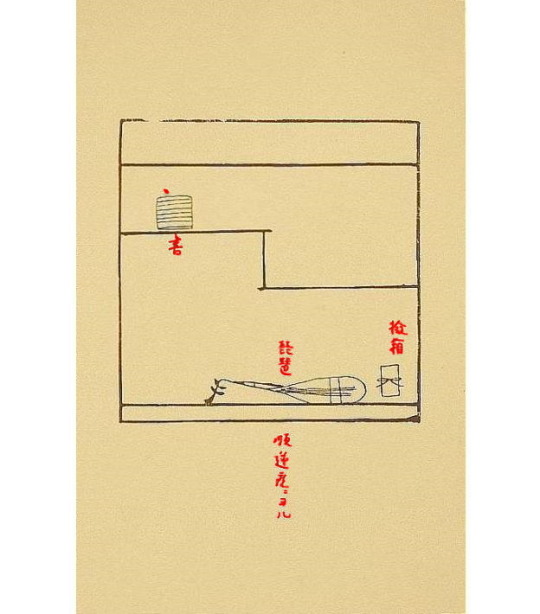
[The writing reads: (from right to left) bachi-bako (撥箱)¹; biwa (琵琶)²; jun-gyaku za ni yoru (順逆座ニヨル)³; sho (書)⁴.]

[The writing reads: (from the right) suzuri ・ ryōshi (硯・料紙)⁵; kō-kazari ha shu-shu sama-sama ari (香カサリハ種〻サマ〰アリ)⁶, betsu ni kō no sho ni ari, koko ni ha ryaku-su (別ニ香ノ書ニ有、コヽニハ畧ス)⁷; kōro ichi-gu (香炉一具)⁸.]
_________________________
¹Bachi-bako [撥箱].
A bachi [撥] is a plectrum, which, in Japan, was usually made from ivory.

The bachi was kept in a special box, to protect it from sunlight (which can cause ivory to become brittle -- it was the inherent resilience that made ivory a suitable material for a plectrum).
According to the entry that discusses the possibility of displaying musical instruments in the shoin (the URL for which is given under the next footnote), the display of a musical instrument was said to be appropriate when either the host, or one of the guests, was known to be passionate about music. The bachi is displayed in its box, nevertheless, because it could not be known whether the biwa would actually be played during the gathering, at the time when the shoin was being decorated.
²Biwa [琵琶].
The biwa is a stringed instrument, similar in many respects to a lute.

While it can be played with the fingernails (assuming they have been allowed to grow long enough*), a plectrum (bachi [撥]) was often preferred when performing.
Shibayama Fugen notes that, while it is a biwa that is shown in the sketch, this arrangement also would be used when displaying any of the musical instruments that were mentioned previously†, including the koto [琴], shaku-hachi [尺八], and fue [笛].
___________
*Which means they will get in the way of other life activities (including eating, dressing, and attending to ones other bodily functions). Thus, only the most ardent of devotees would consider doing away with the plectrum.
†Please refer to the post entitled Nampō Roku, Book 4 (14): Concerning the Display of Musical Instruments in the Shoin, with which this sketch is connected, for additional information.
The URL for that post is:
https://chanoyu-to-wa.tumblr.com/post/190202552504/namp%C5%8D-roku-book-4-14-concerning-the-display
³Jun-gyaku za ni yoru [順逆座ニヨル].
Once again, the location and arrangement of objects on the chigai-dana are subject to the orientation of the shoin itself -- which is, in turn, determined by the location of the tokonoma.
In the case of the two sketches that are being considered in this post, the room has a gyaku [逆] configuration (according to Shibayama Fugen). This means that the toko is on the left side of the chigai-dana (consequently, the set of books is displayed on the side closest to the toko, while the biwa is on the lower side).
⁴Sho [書].
Sho [書] are books. In this case, sho would refer to things like bound scores (gakufu [楽譜]) of music for the biwa*.
It seems that the stack of books was marked with a red spot (in the Enkaku-ji manuscript)† to remind the reader of the fact that -- as Shibayama Fugen points out -- the books should be specifically related to the music of the instrument displayed beneath the chigai-dana.
__________
*A page from the gakufu of the Heike monogatari [平家物語] (“the Tales of the Heike”) is shown below. The annotations for the biwa accompaniment are found to the right of each line of the text.

In pre-modern times, the Heike monogatari was often performed by so-called biwa hōshi [琵琶法師], itinerant minstrels who affected the style of wandering monks. Indeed, it was this piece that is said to have determined the particulars of the style of performance employed by the mendicant entertainers in Japan -- that differentiated them from their counterparts on the continent (from whence the practice is said to have come).
†This spot is not found on all versions of the sketch.
‡Sho to wa gakufu-no-rui naru-beshi [書トハ楽譜ノ類ナルベシ] means “as for the books, these should be examples of musical scores.”
——————————————–———-—————————————————
Shibayama Fugen begins with the comment that this is a sketch of a futatsu-dana [��ツ棚], with the chigai-dana on the left side of the toko (in other words, it depicts the gyaku-toko [逆床] arrangement)*.

“Because the biwa is a rather elongated instrument,” he wrote, “[if] the chigai-dana is 1-ken wide, [then,] with the exception of the first kane on the right-seat, it may extend across all of the other four yang[-kane]†. The bachi-bako, therefore, would be placed on the end-most yin[-kane, on the right].
“If, however, the biwa does not obstruct the right-most yang-kane, then the bachi-bako may be displayed on that kane.” (This scenario is illustrated below‡.)
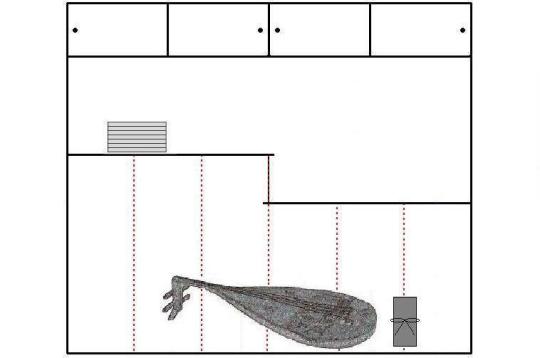
“The books, meanwhile, rest on the first yang kane on the left**.”
___________
*Kono zu ha futatsu-dana ni shite gyaku-toko no kamae nari; kono migi-za ni toko aru-beshi [此ノ図ハ二ツ棚ニシテ逆床ノ構ナリ。此ノ右座ニ床アルベシ].
“This sketch shows the gyaku-toko orientation, [where the toko] is circumscribed [on the right] by a futatsu-dana. The toko is [adjacent to] the right-seat [of the chigai-dana].”
The gyaku-toko arrangement is shown below.

†It might be better to express this idea in English as “because the biwa is a rather elongated instrument -- and depending on the width of the chigai-dana -- it may possibly extend across all but the [first] kane on the left side,” since there was no rule that chigai-dana must be 1-ken (= 6-shaku) wide (the one in the Dōjin-sai [同仁齋] is about 3-shaku wide, though this would be much too small to accommodate a biwa).
“Right seat” is used (by Shibayama) from the perspective of the tana (as if the tana, as an entity, were facing us), as indicated in the above sketch. Thus, the “right seat” is on the viewer's left (which, in this case, is the side closest to the toko).
‡Tanaka Senshō appears to be imagining something similar to the second possibility (where the bachi-bako is displayed on the first kane, and the biwa rests across the middle three) in his brief commentary.
As for the orientation of the collection of objects displayed on and below the chigai-dana, he writes: “with respect to the statement ‘jun-gyaku toko ni yoruᵃ,’ this refers to whether the tenjin [天神]ᵇ looks toward the left, or toward the right -- that is, it should be placed so that it faces toward the toko: this is the rule.
“As for the books, the upper levelᶜ is divided into thirds, and they are placed on the left-most [of the two dividing lines]ᵈ, while the biwa rests on the central kane. Though it appears [in the sketch] that the bachi-bako is removed from the [yang] kane, might it [not] be that it is [placed] on the right-most of the yang-kane?
“Also in such circumstances, that nothing should be placed on the shelf aboveᵉ, is the rule.”
___________
ᵃJun-gyaku toko ni yoru [順逆床ニヨル] means “[whether] jun [or] gyaku [orientation] depends [on the location of] the toko.”
Apparently Tanaka Senshō’s teihon [底本] differed from the Enkaku-ji manuscript (where the text of this kaki-ire is given as jun-gyaku za ni yoru [順逆座ニヨル], meaning that whether the arrangement is oriented toward the right, or toward the left, is a consequence of the orientation of the room itself) -- the corresponding kaki-ire on the sketch in Shibayama Fugen’s commentary agrees with Tanaka’s version. Regardless, the actual implication is the same.
ᵇTenjin [天神] means something like “Heavenly Spirit(s),” “Heavenly Kami,” or “the Lord of Heaven.” It is sometimes used as a way to express the identity of the Christian Deity (by certain Protestant sects) when translating their teachings into Japanese.
In Japan, however, Tenjin can also refer to the deified form of Sugawara Michizane [菅原道眞; 845 ~ 903], in his capacity of the God of Poetry. But what Tanaka Senshō actually intends here, in relation to the rule he is attempting to enunciate, is unclear. (Perhaps Tanaka is thinking of something that is extremely important, or precious? Or, with reference to the object of greatest importance in the display? At any rate, he seems to be saying that the most important object should be displayed in closest proximity to the tokonoma; and that, then, would presumably be his rule.)
ᶜJō-dan [上段] means the upper, or higher, level. Here, Tanaka is referring to the shelf, which is suspended above the ji-ita on which the biwa is arranged.
ᵈMitsu-wari hidari no kane [三ツ割左の曲尺]. Tanaka’s expression might be confusing. He means that the shelf is divided into thirds by means of two kane, and the books are displayed on the left-most of those.
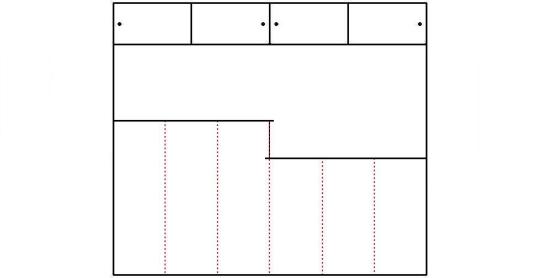
Reading his interpretations of these last several sketches, it is difficult to believe that he fully understands the significance of the entire width of the alcove in which the chigai-dana is located being divided by five kane (as shown above), and that the kane of which he is writing are actually part of that system.
In fact, the five-kane system was the original system, and remains so to this day. In the case of shelves that only cross half-way (such as are seen here, with respect to the chigai-dana, or on an ō-dana [大棚] such as the fukuro-dana [袋棚]), the individual shelves partake of half that number. Jōō’s seven-kane system was in fact the result of a failure of the same sort of logic (that his system has persisted, in the inaka-ma context, was because the space between the kane on an inaka-ma tatami is small enough that it precludes one thinking in terms of interstitial yin-kane, and so simplifies matters somewhat -- while ultimately achieving essentially the same results), but it seems that Tanaka took this to mean that one is free to choose between different systems of kane-wari, in order to get the desired results. In fact, the same is true of the eleven-kane system (where the six yin-kane have been interspersed between the original five yang-kane): originally, placing something in the space between the five yang-kane was considered “removing it from the kane.” In Chinese yin-yang theory, removing it from the kane is yin (while aligning the object with the kane is yang). Since the old rule was that things should be centered whenever possible, this seems to have lead to the interpretation that there is a “yin kane” in the interstice between each pair of yang-kane (and between the end-most kane and the heri); but this is more a philosophical slight of hand than an actual rule.
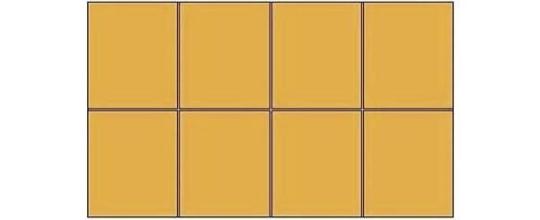
The kane were a philosophical extension of the folds and edges of the shiki-shi [敷き紙]. The panels of the shiki-shi were then considered yin (as flat planes are considered yin, while lines are yang). But to extend this idea too far -- as happened in Japan, when the fact of kane-wari being rooted in the shiki-shi was forgotten -- can lead more to confusion, than to clarity. (This is especially so when recourse is then taken in the Chinese yin-yang system -- which has little actual relevance to the understanding of kane-wari.)
The same can be said of the idea that the space used for the temae extends onto the inner 5-bu of the heri. This was certainly true when the shiki-shi was actually used, since, when placed on top of a kyō-ma tatami, the shiki-shi (as a consequence of the 3-bu widths of the the three folds) leaves only 4-sun 5-bu exposed on both sides, thus requiring that the host appropriate the inner 5-bu of the heri so that centering objects between the folds of the shiki-shi, and between the outer edges of the space employed during the temae, utilizes spaces of equal width. But once the shiki-shi was physically eliminated, the three inner kane shrank from 3-bu wide to simple lines (like the kane derived from the edges of the shiki-shi), thus drawing the left and right extremities of the space needed for the temae inward, to the inner edge of the heri. Therefore, Rikyū urged people to count the lines on the mat in order to locate the kane, without being concerned about anything beyond the edge of the heri, since the inner half of the heri will no longer be included in these calculations. This can all be clearly demonstrated by arranging the special gokushin tray (the Gassan nagabon [月山長盆]) that is discussed in Book Five and Book Six, in front of the daisu, vis-à-vis the shiki-shi (which requires the foot of the tray to rise up onto the heri), and the subsequent situation where the shiki-shi has been removed (in which case the tray is moved 5-bu toward the middle of the mat, so that the edge of its foot is simply adjacent to the heri). It is really much easier to understand all of this when these things can be observed physically, rather than just described “philosophically,” since the entire reasoning becomes unmistakable. Ultimately, this is why Rikyū held that the guiding principal of wabi no chanoyu is always rooted in the tea of the daisu.
ᵉHe means nothing should be placed on the shelf above the biwa and the bachi-bako.
To elaborate this idea into the form of a rule (which his statement actually does not), nothing should be placed above on any of the kane that are already occupied by the biwa and bachi-bako. Yet his statement, in fact, reads: kono toki mo uwa-dana ni ha nani-mono mo okanu ga hō de aru [此時も上棚には何物も置かぬが法である], which literally means “also at this time, also on the upper shelf, something should not be placed: this is the rule.”
**The rule, according to Shibayama, is that the same kane should not be occupied above if it is also occupied below. This rule was also stated by Tanaka (in the sub-note just above this one).
——��———————————–———-—————————————————
⁵Suzuri ・ ryōshi [硯・料紙].
A suzuri [硯] is an ink-stone; ryōshi [料紙] is high-quality writing paper. The pack of paper was folded in half, and the ink-stone was rested on top (as a sort of paper-weight).
⁶Kō-kazari ha shu-shu sama-sama ari [香カサリハ種〻サマ〰アリ].
“With respect to the display of the incense [equipment], there are numerous ways, with a multitude of variations.”
The objects displayed would have been the most special ones owned by the host. Book Five describes in detail a number of ways that the incense set could be displayed on the daisu.
⁷Betsu ni kō no sho ni ari, koko ni ha ryaku-su [別ニ香ノ書ニ有、コヽニハ畧ス].
“[This arrangement] is different from what is shown in the books of incense. Here things have been abbreviated*.”
In Japan, the original incense gathering, like the original tea gathering (tō-cha [闘茶]†), was a kind of guessing-game where the participants were charged with identifying different varieties of kyara incense by smell; and these contests were governed by a game-specific set of complex rules and conventions.
The Shino family apparently introduced the notion of sniffing incense purely for its own sake‡ -- as an experience in positive samadhi. And when Jōō, then, incorporated this kind of experience into his chakai, he simplified things even more by incorporating incense following the sumi-temae, so that he could make use of the corresponding charcoal utensils, rather than using the full set of traditional kō-dōgu [香道具]. These simplifications** naturally necessitated modifications to the way that the objects were arranged on the kō-bon.
Note that the kanji ryaku [畧] is usually written ryaku [略] today.
__________
*According to the incense schools, the kyōji-tate usually contained a pair of kyōji [香筋] (ebony or ivory chopsticks used to handle the pieces of incense), a small feather brush (for cleaning the censer after arranging the ashes), a pair of koji [火筋] (bronze chopsticks used to handle the burning charcoal), a hai-oshi [灰押] (a flat, spoon-like utensil, used to press the ash into shape)ᵃ, an uguisu-kushi [鶯串] (a silver needle resembling a toothpick, inserted through a hole in the middle of a plum-blossom shaped metal plate, used to create a chimney in the ash and flat platform on which the gin-yō can rest), and a gin-yō-basami [銀葉挾] (a kind of forceps used to handle the gin-yō [銀葉] -- mica squares on which the pieces of incense were heated).
However, in the context of a chanoyu gathering, several of these things could be replaced with the utensils used when preparing the charcoal fire, and it is this to which the expression ryaku-su [略す] (abbreviated) refers.
__________
ᵃIt is possible that earlier references to a kō-saji [香匙] (which is a sort of long-handled spoon also used when handling the incense), are actually talking about a hai-oshi [灰押] -- since it seems that the kō-saji was usually used to scoop the individual pieces of incense out of the compartmented jin-bako [沈箱] (in which the incense was stored after being cut into small pieces), and place them into the ko-tsutsumi [香包], all of which was usually done in the katte. The kyōji [香筋] were used when transferring the incense from the kō-tsutsumi into the kōro. Consequently, there would be no reason why the kō-saji would have to be displayed in the shoin -- while the hai-oshi would be needed when preparing the censer (which was done in the shoin, immediately before it was used).
†Tō-cha [闘茶], in its simplest form, consisted of drinking a series of bowls of thin tea, prepared in the Chinese mannerᵃ, after which each guest stated what he believed to be the correct order in which the bowls of tea had been servedᵇ.
Usually the guests offered their opinions after drinking five, or perhaps ten, bowls of tea in succession (which constituted one “inning”). Surviving records suggest that there could be up to a 20 innings, or possibly even more, in one competition, with the guests drinking 70 or more bowls of usuchaᶜ.
Tō-cha only involved the drinking of usucha. The service of koicha was the distinguishing feature between this early type of tea gathering and the chanoyu -- and even though the two institutions have been conflated since Kanamori Sōwa produced his “history” of chanoyu in Japan (at the behest of the Tokugawa bakufu), the two practices, in fact, have nothing to do with each other, historically or otherwise, beyond the fact that both employ matcha.
___________
ᵃA dai-temmoku containing a scoop of matcha was presented to each guest from a tray (on which they had all been carried out at the same time -- allowing for visual comparison of the matcha), after which a second server poured hot water into each bowl from a hand-held pitcher, which was whisked into usucha, and so drunk.
ᵇIn other words, he decided whether each of the bowls was “hon-cha” [本茶] (meaning tea grown in the tea fields at the Kozan-ji [高山寺], located on Toga-no-o-yama [栂尾山], on the western outskirts of Kyōto), or hi-cha [非茶] (this term referred to tea that had been grown in some other place) -- though later the number of named options increased to three, or even four, varieties of tea.
ᶜWhich probably induced a state of caffeine inebriation in all of the participants before the gathering was concluded -- even though the innings were usually separated by intermissions (when trips to the lavatory or bath, food and sake, and even the opportunity to have sex with the servers and other attendants, were available to the guests).
‡Meaning that the gaming boards, and many of the other “necessary” accoutrements (that were often designed as a way to avoid conflict), could be dispensed with.
It is important to note that after the original Korean lineage died out (toward the end of the sixteenth century), management of the Shino school was taken over by their Japanese disciples -- who discarded the original meditative practices in favor of elaborating their own versions of the popular incense guessing-games during the Edo period (when competition for lesson fees became intense).
**Ryaku-suru [略する], in addition to “abbreviate,” also means things like “to abridge,” “to foreshorten,” “to shorten,” “to reduce,” “to take out,” and so forth.
⁸Kōro ichi-gu [香炉一具].

This means “a set of incense utensils” -- which, in this case (according to the sketch), includes a kōro [香爐] (left), kyōji-tate [香筋建]* (toward the rear), taki-gara-ire [炷空入]† (toward the front), and kōgō [香合] (on the right), arranged on a kō-bon [香盆]‡.
__________
*A kyōji-tate [香筋建] is a small, vase-like, stand (similar to a miniature shaku-tate), in which the utensils used to prepare the incense burner are stood. These things are enumerated in the sub-note attached to the previous footnote.
†A taki-gara-ire [炷空入] is a ceramic (or sometimes metal) lidded container, of the same size as a kōgō, into which the used gin-yō (with the piece of burned-out incense fused to its surface) is discarded.
The taki-gara-ire was supposed to be selected to complement the kōgō. (In the photo, for example, while the kōgō is in the shape of a turtle, the taki-gara-ire features a painting of lotus and water plants.)
Most of the old ceramic kōgō were originally used as taki-gara-ire. They were first used as kōgō by Jōō -- when he began to use neri-kō [練り香] with the irori (because these ceramic containers could be cleaned of the sticky incense residue in water, while lacquered kōgō could not).
‡The kō-bon was always a kuguri-bon -- that is, one large enough that it would cross two kane. The reason why becomes obvious during the discussion of this arrangement.
——————————————–———-—————————————————
Shibayama Fugen begins by noting that this, once again, shows a futatsu-dana, in a room arranged according to the gyaku-kamae orientation*. The toko adjoins the right seat†; and, in this room, the shelves are of unequal length (with the leg that joins the lower shelf to the upper located on the second kane), as shown in the following sketch.
This, he adds, shows the chigai-dana as it would be arranged for a kō-kai [香會], a gathering during which incense will be appreciated‡.

The kō-bon [香盆] is centered on the first kane, and the ryōshi [料紙], with a suzuri [硯] placed on top (where it functions as a paperweight), is centered on the second kane from the right.
__________
*Gyaku-kamae [逆構え] means the toko is “enclosed” (by the alcove in which the chigai-dana is suspended) on the gyaku-side (which means, on the right). In other words, the chigai-dana acts as one of the walls of the tokonoma.
The tsuke-shoin (whose window provided the primary source of natural illumination to the toko and chigai-dana) would be attached to the toko on its leftᵃ. (This can all be seen in the sketch of the gyaku-toko arrangement that was included under sub-note “*“ in the previous commentary.)
While described as the gyaku (“reverse”) orientation in Book Four of the Nampō Roku, this was, in fact, the original, preferred orientation, during the early days of chanoyu. This is why most of these sketches (which date from near the beginning of Jōō’s public career) depict the gyaku, rather than the jun, orientation. The jun (“correct”) orientation only became defined as such during the last decades of the sixteenth century, at the insistence of Hideyoshi.
___________
ᵃUltimately, it can be argued that the reason why the objects displayed on the chigai-dana should face toward the toko is because that is the direction from which the light comes.
This is also the reason why the most important object displayed on the chigai-dana is also placed in closest proximity to the tokonoma.
†As in the previous sketch, the right seat is defined from the perspective of the chigai-dana -- as if it were facing toward the viewers. The “right seat” is on the viewers' left.
‡This kind of gathering, and its several associated conventions (as they relate to the possibility of the inclusion of the service of tea during a kōkai), are discussed in the post entitled Nampō Roku, Book 4 (17): the Display of a Kiki-kōro [聞香爐] in the Shoin.
The URL for that post is:
https://chanoyu-to-wa.tumblr.com/post/190390070765/namp%C5%8D-roku-book-4-17-the-display-of-a
0 notes